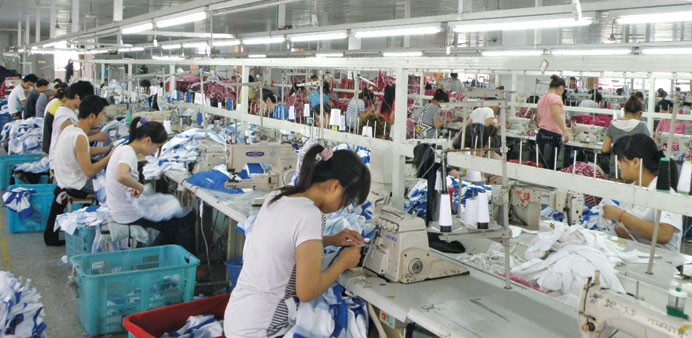Workers at a garment factory in Xinjiang region. China’s factory output growth in April likely picked up to 6% from 5.6% in March.
Reuters/Beijing
A deluge of China data over the coming week is likely to show some signs of steadying in the world’s second-largest economy, but economists still expect Beijing to roll out more stimulus measures to support growth.
Industrial output and retail sales may have expanded at a slightly better pace in April, while fixed-asset investment growth is seen holding steady.
But the property market – seen as a key drag on the economy – likely remained weak and erratic global demand continued to weigh on exports.
“Despite tentative signs of stabilisation, real activity has stayed generally weak, with faltering PMI new orders and rapidly declining producer prices pointing to still frail domestic demand and worsening corporate balance sheets,” economists at UBS said in a note.
“In other words, although the sharp slide in March’s real activity has likely been arrested, further policy support would be needed if growth were to get close to this year’s target of 7%.”
UBS expects the central bank to cut interest rates again over the next two months and cut banks’ reserve requirement ratio (RRR) by at least another 100 basis points this year.
Factory output growth in April likely picked up to 6% from March’s 5.6%, which was the weakest reading since the global financial crisis, while retail sales growth may have quickened to 10.5% from 10.2% in March. Fixed asset investment is expected to rise 13.5% in the January-April period, the same as in the first quarter.
Export growth may have rebounded to 2.4% in April from a surprising 15% tumble in March, partly due to the yuan’s appreciation against major non-dollar currencies.
However, imports likely fell 12% in April from a year earlier, not as bad as a 12.7% fall in March but highlighting that domestic demand remained tepid.
Broad M2 money supply is seen up 11.9% in April compared to a year ago, up from March’s 11.6%.
But the amount of new loans disbursed by banks was seen falling to 903bn yuan ($145.62bn) last month from March’s 1.18tn yuan.
Annual consumer inflation is seen at 1.6% in April, up from 1.4% in March, but well below the annual government target of 3%, the poll showed.
In a further sign of sluggish demand and sustained pressure on profit margins at Chinese companies, producer deflation was expected to have persisted for more than three years in April, with the producer price index seen falling 4.4% versus 4.6% drop in March.
The central bank has delivered two interest rate cuts since November, on top of two reductions in the amount of money banks must keep in reserve and repeated attempts to reduce financing costs. Restrictions on mortgages have also been eased in a bid to put a floor under falling home prices.
Annual economic growth slowed to a six-year low of 7% in the first quarter and the government faces an uphill battle to attest the slowdown due to the property downturn, widespread factory overcapacity and local government debt.
China’s economic growth is expected to cool to a quarter-century low of around 7% this year from 7.4% in 2014, even with additional stimulus measures.



